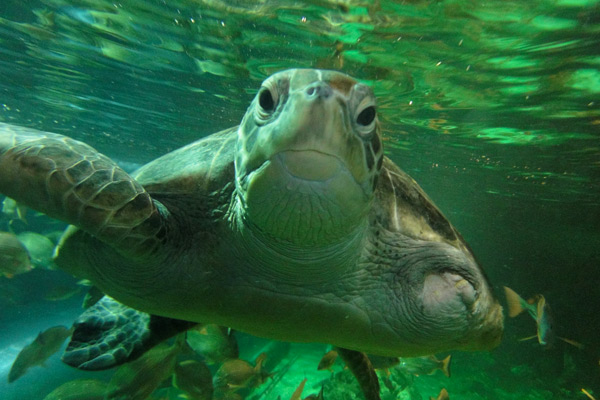Chris & Allyson vs. Australia (May 2012)
Day Four: The Blue Mountains. The Three Sisters. Katoomba. Norman Lindsay.
Real travelers know that the only way to enjoy a city as the locals do is to leave it. Cities are smelly cauldrons of humanity, and no self-respecting resident would spend all their time there. If you hang around downtown for five days, you're missing out on that authentic need to get away from your disgusting fellow man.
In Washington, that means a trip to the beach or the mountains. Sydney already has beaches, but the Blue Mountains are just 50 or so miles inland. So on day four of our Australian adventure, we actually took things to a more dangerous level than the shark orgy of day three. We rented a Hyundai, at a hotel two blocks from Circular Quay. That meant driving through downtown in the morning rush as we tried to get back to nature.
Traffic in Australia isn't so bad. The Harbor Bridge is the most heavily-traveled roadway in the country, and standing a few hundred feet above it two days earlier, it didn't seem all that backed up; there was worse congestion in "The Road Warrior." Everyone thinks the traffic where they live is the worst in the universe -- stand-up comedians have built careers around this fact -- but in Washington it's not unusual to change your party affiliation based on whose motorcade made you five hours late for a house party. Sydney traffic is bush league.
The problem is that they drive on the wrong side of the road, with the wheel on the wrong side of the car. Some say there is no "right side," but those people don't come from the country that perfected the mass-produced car. We win, Australia, and as gracious winners, we defer to you on questions of Australian Rules Football and vegetable paste.
Of the two people currently involved in our marriage, I have the best eyes and the most experience driving around the downtowns of strange cities during rush hour. I study maps, and if you give me half a day in any city I'll be able to get you respectably lost (i.e. within a mile of where you'd like to go). So I had the privilege of easing the Hyundai onto the road, trying to get a sense (from what should be the passenger's seat) of where we were in the lane, and trying not to murder Australians with the bumper, even though I love "The Road Warrior." Allyson had the pleasure of riding along and taking some pictures that forensic teams might find useful, should the digital camera survive the crash. Once we got past the suburbs and onto the highway, she gave a huge vote of confidence to my driving ability by lapsing into her usual road coma.
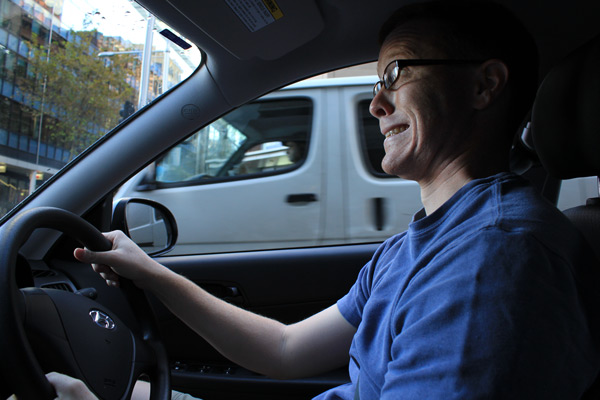
The incredible oneness between driver and road.
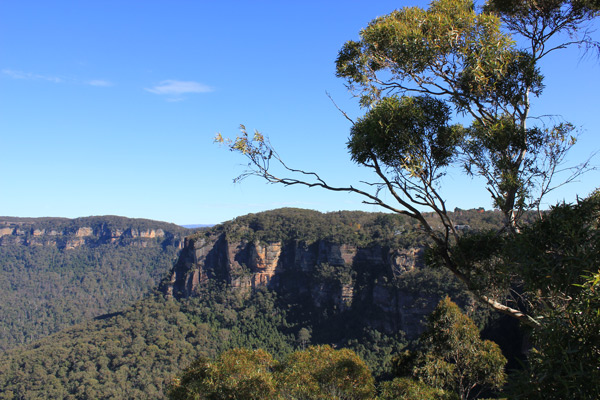
An overlook of the Blue Mountains.
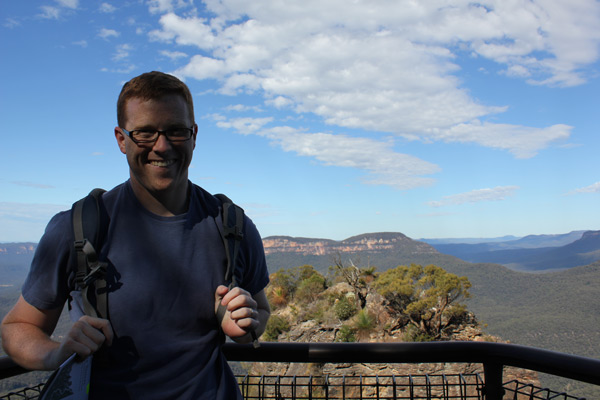
Blue shirt. Blue Mountains. That's what we call synergy.
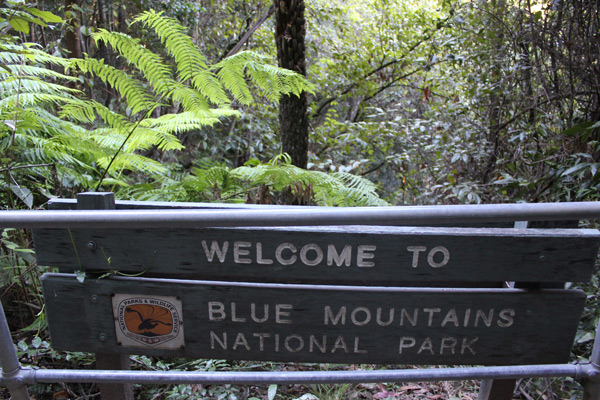
Walking the trails of the Blue Mountains.
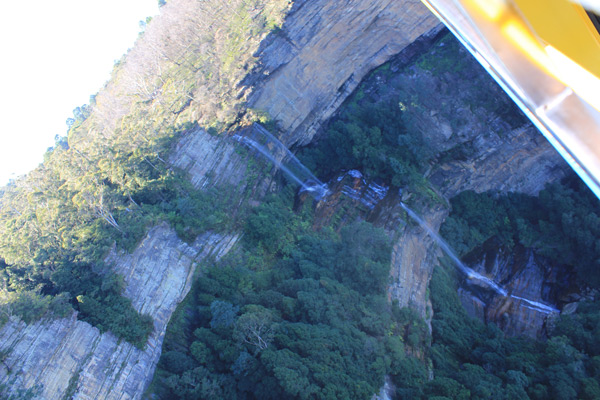
Hey, they have waterfalls in Australia! Who knew?
That let me road test the Hyundai in peace. It handles like a smallish economy car with the steering wheel on the wrong side. Does it have a decent amount of power? It might. I could tell you for sure, had I tried to pass anybody. But mostly, I was focusing on not driving on the wrong side of the road, and not turning on the windshield wipers every time I wanted to use the turn signal.
We made our climb into the "mountains" of eastern Australia on a nondescript highway, through towns that aren't that big -- because Australia has 23 million people total. We passed a lot of the venues from the 2000 Olympics, but since we didn't have our kayaks or pole-vaulting equipment with us, we kept driving. Getting there wasn't half the fun -- there's no South of the Border -- which left more fun for our destination.
The Blue Mountains are a United Nations World Heritage Area, which means that a team of international heritagicians met at Turtle Bay, studied an exhaustive series of reports, embarked on a 30-minute sample walkabout with authentic Australian guides, then deemed the region worthy. The designation empowers the Australian tourism authorities to promote the region as a United Nations World Heritage Area, which in turn allows tourists to pick up brochures in hotel lobbies and say, "What the **** is a United Nations World Heritage Area?"
I can tell you with greater certainty why the mountains are blue. The wilds outside Sydney are covered with eucalyptus trees, and as the oil from their leaves disperses into the atmosphere, it creates a bluish haze. Wanting to breathe in that oil-laden air -- bluelung be damned -- we decided to start off our day with a hike.
The Hyundai rolled into the former mining town of Katoomba in the late morning. It's a cute town, just off the highway; you go through one traffic circle, past four or five scuzzy souvenir shops on the main drag, and suddenly you're at Echo Point.
Echo Point is where you look at the Three Sisters, a sandstone rock formation that has been a major tourist draw since the days when looking at rock formations was enough to entertain the world's children. The aboriginal legend is that three women were sought for marriage (or by the Australia chupacabra, or by something that causes problems for three young women). Their father (or a witch doctor) turned them into stone to protect them. Then he died (or was otherwise incapacitated) before he could turn them back. If you're sensing ambiguity, it's because the aboriginal legend might have been made up by some white guy from Katoomba in the ‘20s. This seems likely, because if you're taking the legend at face value, the women would have to be 1,000 feet tall. And who wants to marry or eat that?
Regardless, the spot has aboriginal significance, so let's talk about the aboriginals. In America, we've come to terms with crushing Native Americans under foot. Australia isn't there yet. We didn't see many aboriginals on our trip, but the ones we saw were charity cases -- people wandering around aimlessly, looking very pissed off. We did see a guilt-fest of aboriginal culture, because everyone in Australia's arts community is very passionate about letting you know what a horrible person you are for participating in the rape of the native people. Most white Australians are tired of hearing about it, think the aboriginals are wallowing in the past and would rather talk about sports. It makes for interesting dinner conversation. Go for it once the first bottle of wine is empty.
There were no aboriginals, however, at the scenic overlook. There was just a lot of wind. I was wearing shorts and a t-shirt and was fairly comfortable; Allyson wore a fleece, pants and gloves and was still cold. Allyson is always cold, because she enjoys none of the natural insulation that I carry around at all times. Also, she has sensitive eyes that water in the slightest breeze, so if we walk down the street together on a sunny day it looks like I am distressingly nonchalant about abusing her.
Fortunately, there weren't too many people to stare at us on the Giant Stairway, which has 861 steps that take you 1,000 feet down to the floor of the Jamison Valley. The stairway was made by the most powerful force in the universe: Depression-era labor. You need to be hard-up before you're willing to spend a few months hacking into a rock face in exchange for a sandwich.
It's a nice hike. Eucalyptus trees are ungodly tall, and as you pass through the canopy you can hear the shrieks of Australian birds. Very few birds on the continent sing; instead, they yell like tiny avian stabbing victims. It's a beautiful, natural thing. We didn't spot any ground-based critters dancing around the ferns on the forest floor, but with our eyes on the floor we did spot the very helpful message -- maybe carved into the ground by a surly Depression guy -- letting us know that we were halfway. As we hiked, we talked of wonderful things. I commented on the beauty of the trees and sky, and Allyson mentioned that the outdoors pretty much bore her. It's nice to complement each other.
The tough part about hiking down, aside from crippling knee pain, is hiking back up. But as this was vacation, we had it covered. The trail wound up at the base of the Katoomba Scenic Railway. As I mentioned, Katoomba was a mining town. They had to get the coal and miners at the bottom of the valley up to the top of the valley, where respectable society (and the train tracks) were. They built a funicular, which is the far cooler term for "incline railroad."
No one needed to get coal out of the valley after the 1940s, but funiculars are exactly the sort of unusual means of transport that you can charge people $15 to ride. We milled around the lower platform for a few minutes, watched the cars arrive, saw a swarm of Asian tourists get off ("swarm" and "murder" are the proper terms for groups of Asian tourists), then took our seats in the very front car.
It took you longer to read that last paragraph than it took us to reach the top. But what a ride! The funicular has a 52-degree slope, making it the steepest railway in the WORLD. You're strapped in so that you have to face forward, looking out on the valley, and you climb very fast. It's exhilarating. Not exhilarating enough to make you want to purchase a Katoomba Scenic Railway t-shirt for another $15 when you reach the gift shop at the top, though. Save your money, because you're going to need it for the Katoomba Skyway.
That mode of conveyance takes you from one rock outcropping to another, via cable car, across a mighty gorge. You go right past the towering Katoomba Falls, and as you stare at that natural wonder, you will enjoy a moment of universal oneness as a murder of Asian tourists shoves you aside so they can take more pictures. One 50-year-old Japanese lady with a camera could probably box out most NBA centers if there was a waterfall near the baseline.
And now a quick word on racism. This was our second encounter with pushy Asian tourists, and we hate to indulge in stereotypes. You're not making it easy, people of Asia. I know that many of you come from crowded cities and have different cultural notions of personal space. But please know that waterfall pictures will not sustain you in your old age. Only friendship can do that, and you're making it very hard for us to be friends. You're better than this, Asian tourists.
Back to the narrative. Walking seemed pedestrian after scenic railways and skyways, but we did have to get back to our car. So we took off along the ridgeline, through Katoomba's quiet residential neighborhoods, and made our back to Echo Point. We were pretty hungry at this point, but there was the small matter of letting Allyson drive. We did a quick spin through the lightly-trafficked neighborhoods, stashed the bodies of the few hoboes she rolled over, and then went to lunch. We ate at Common Ground, a coffee shop and restaurant decorated like a hobbit residence, with lots of knotted wood interiors, a fireplace and hairy-footed employees. It was delightful and unremarkable, and after settling up we decided to head back to the big city.
There was one stop on the way. Norman Lindsay was one of Australia's great all-time perverts, and he also wrote children's books. His meal ticket was cartooning -- Lindsay drew for the Sydney Bulletin in the first half of the 20th century -- but his talents were many. He was a master engraver, a painter, a builder of model ships, and, as I already mentioned, an author. "The Magic Pudding" was a children's book about … well, a magic pudding. It was awesomely popular, and it's still in print today. Probably because half of the characters are Australian animals in formal wear, and kids love that stuff.
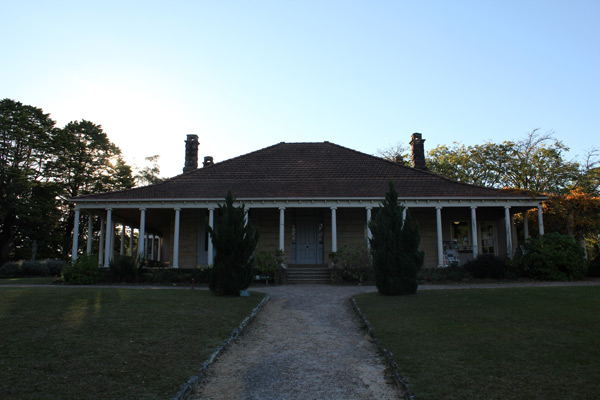
Norman Lindsay's quaint home.
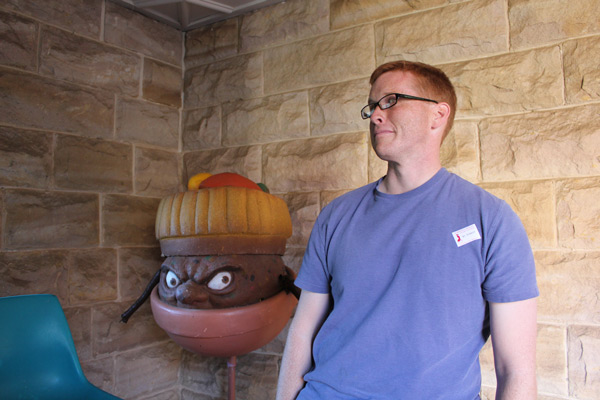
One of these is a distressing character from a children's book written by a pervert.
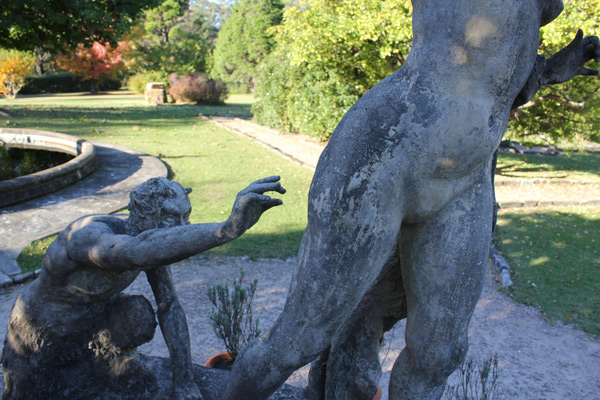
The art of Norman Lindsay in one simple image.
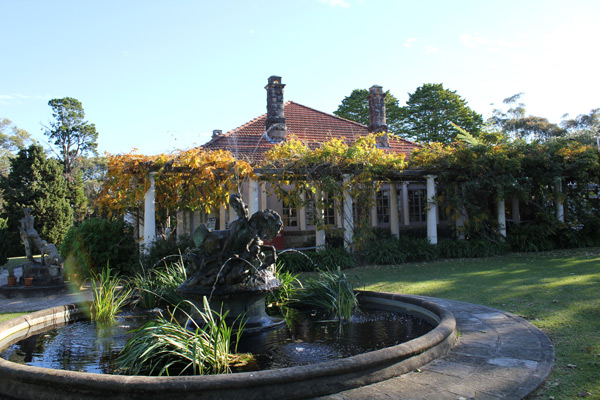
A wider shot of Lindsay's home / gallery.
As far as him being a pervert: Lindsay loved painting naked ladies, and particularly the curvier ones; apparently, if models came in a size 10, they were a size 14 on canvas. All of his paintings have very busty and exceedingly naked chicks in a series of fantasy-themed poses, where they are nymphs or succubi jiggling their goods in menacing ways. He also sculpted lots of naked ladies doing exciting things like cupping their huge bosoms.
Amazingly enough, I thoroughly enjoyed Faulconbridge, the nice little Blue Mountains town where Lindsay built his home. You've seen the house if you saw the 1993 movie "Sirens," and you definitely saw "Sirens" if you were a teenage guy in a pre-Internet era who wanted to see Elle Macpherson naked. The movie was a fictionalized account of Lindsay and sexual awakening, and I can't recommend it enough if you're a lonely high school junior.
It's an interesting little tour. The main house has been converted to a gallery of sculptures and paintings. There's a separate studio building where Lindsay did most of his drawing and painting (and sleeping, when his perverted, cheating ways put him on the outs with his wife). And there's an engraving studio where he made prints. Lindsay decorated the grounds with sculptures, done in a style he basically came up with on his own; he made metal frames, then kept adding layers of concrete until the boobs were big enough.
Lindsay is easy to both admire and hate, because everything he did, he did well. And I'm glad we saw his home, because I can't think of a single other Australian artist who I'm aware of. As far as important Aussie painters go, I've now seen all their homes. We also had a great docent with an accent you couldn't cut through with Crocodile Dundee's knife. And the grounds were swarming with cockatoos, which are the avian equivalent of a rape whistle. There was a lot of authenticity going on.
We had to leave eventually, because if we didn't get the car back by 6 p.m. I was getting charged for an extra day's rental. We were driving into the city at rush hour, so traffic was in our favor. But you can't just follow directions in reverse in a major downtown -- and rush hour shows no mercy once you're in the city. Plus it was twilight, so it was harder to see just how close to parked cars and buses we were coming. We guessed at which exit to take, sat in traffic, and inched closer to our goal. Swimming with sharks was exciting, but with an extra day's rental fee on the line, this was pulse-pounding. We got the car parked at 5:55. It made me feel like a man.
And after all that excitement, we were ready for an easy night. We had dinner at the Argyle, a trendy-looking bar and restaurant two blocks from the hotel that we had first seen on our walking tour of The Rocks. There was a DJ spinning throughout the whole meal, and the bar had a vending machine that sold disposable flats for women who were tired of walking in heels. We took a little stroll around the neighborhood to show Allyson some of the sights I had enjoyed while jogging, then we had a drink at the Fortune of War, which is allegedly the oldest pub in Australia. It's a dump, but they serve beer, and there were no Asian tourists there.
